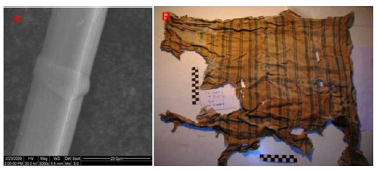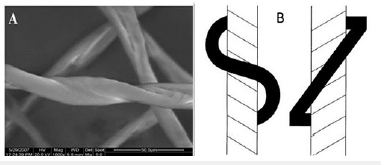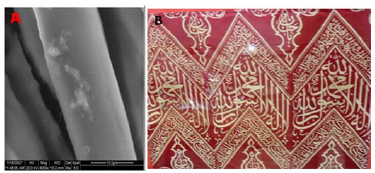- Submissions

Full Text
Trends in Textile Engineering & Fashion Technology
Brief of Natural Fibers in Historical Textiles Manufacturer
Harby E Ahmed*
Archaeology Conservation Department, Cairo University, Egypt
*Corresponding author:Harby E Ahmed, Archaeology Conservation Department, Faculty of Archaeology, Cairo University, Egypt
Submission: March 15, 2022; Published: April 04, 2022

ISSN 2578-0271 Volume 6 Issue 4
Introduction
Historical textiles in museums form an important part of our cultural heritage, due to their historical aesthetic appeal and cultural significance (Anders G, 2000; Flury L, 1988). In general, the term textiles refers to fabrics woven in heritage collections; however, the term textiles has a broader meaning than that as it covers materials that are produced by other means [1]. Some examples of textiles that you may find in museums are (costume, uniforms-millinery- tapestries-ecclesiastical textiles-carpets and rugs-dolls, parasols and fans-patchwork and appliqué - flags and banners-quilts-teddy bears-needlework).
Textiles in Ancient Egypt
Many inscriptions in ancient Egyptian tombs refer to the ingenuity of the ancient Egyptians in making textiles. The preparation of textiles in ancient Egypt was considered as a rule to be woman’s work, because the goddesses Isis and Nephthys had woven, and made clothes for their brother and husband Osiris. Linen textile is the most widely used fabric in all of ancient Egypt. Because it is very suitable for the hot Egyptian climate, a second advantage was that it could be loosely woven into gauze that allowed air to circulate around the skin [2]. Woolen textiles were rare in the ancient Egyptian civilization but were widely used in the Coptic era. As for cotton textiles, it reached Egypt in the Roman era. The use of silk textiles has spread in Islamic times. The fibers are converted into yarns by spinning, which strengthens the fibers and makes them suitable for weaving processes. Ancient Egyptian spindles consisted of a wooden shift, around four inches in length, through which a whorl-a two-to-four-inch disk was attached nearer the top than the bottom. First, the fibers were tied to a groove at the top of the spindle, and then the spindle was rolled vigorously down the spinner’s thigh which set it spinning, stretching the fiber by its weight while twisting it for strength. This produced thread of a consistent diameter. After the completion of the conversion of fibers into threads, weaving operations begin [3]. The ancient. Egyptian looms were horizontal, and their use appeared in prehistoric times, then there was a development in the shape of looms in the later ages of the ancient Egyptian civilization, and they became vertical looms [4].
First Cellulosic Fibers
Linen fiber
Linen fiber is one of the most famous fibers used in the manufacture of textiles in ancient Egypt. Found in Egypt since the Neolithic era and the pre-dynastic era. Flax cultivation is still abundant in Egypt until now. The natural flax fibers vary in length, as the lengths of the fibers range from 25 to 150cm, and the average diameter of the fibers is 12 to 16 microns. Where short fibers are used to manufacture coarse linen textiles and long fibers are used to manufacture fine linen textiles. The percentage of cellulose in the raw flax fibers reaches about 70-85% of the weight of the fibers, in addition to about 9% of water and moisture, pectin 3%, other materials 3.3%. Linen clothes in ancient Egypt were considered to be a symbol of purity, so the vestures of the priests were made from linen and also Linen bandages for the mummies [5]. Ancient Egyptian people mostly wore linen clothes during the first millennium BC. But by Roman times, many people wore linen tunic for comfort with woolen robes worn over them for warmth (Figure 1).
Figure 1:(A) Show the SEM of Linen fiber. While (B) show the ancient Egyptian linen textile.

Cotton fiber
Figure 2:(A) Show the SEM of Cotton fiber. While (B) show Historical yarn spinning left or right.

Cotton fibers have been used in the manufacture of historical textiles since ancient times. There is no doubt that India was the original home of cotton fibers, from which it spread to the countries to the west, and this is supported by the fact that cotton textiles were found in Mongodaro - one of the cities of India - dating back to between 2750BC. AD to 2250BC. M. Herodotus 445 BC mentioned that wild wool trees grow in India and produce more beautiful and breathable wool than sheep’s wool, and that these trees provide the Indians with the clothes they need. It was found in Egypt for the first time in the middle of the sixth century BC. AD, where Herodotus talks about the scope of the tunic that King Ahmose II (570 - 526) gave during the era of the Twenty-sixth Dynasty (664 - 525BC) to the rulers of Greece. Cotton fibers are characterized by several characteristics that made them suitable for the textile industry throughout the ages. Cotton fibers contain about 88-94% cellulose of the dry weight in raw cotton, which is the main component of the staple. Cotton also contains a percentage of waxy materials (Figure 2).
Secondly Protein Fibers
Wool fibers
A closer look at the Egyptian textiles during the Pharaonic eras, we find that the ancient Egyptians produced very little wool, because of a purely religious reason, which is that the ancient Egyptians believed that animal wool fibers were not pure and believed in the purity and sanctity of linen fibers [6]. Wool contains keratin, which is the main compound, about 40% of the weight of raw wool. It consists of the elements carbon, hydrogen, nitrogen, and sulfur, in addition to the skin secretions of 28%, which are the secretions of the skin glands, which contain fatty acids such as stearic and oleic acid. There are also greases such as lanolin grease about 12% and impurities 20%. Wool fibers have the property of flexibility and recovery, which is the ability of wool fibers to restore their shape after the removal of the influence. The woolen textile industry spread in Egypt during the Coptic and Roman eras [7]. We find very exquisite and accurate woolen textiles in the industry during this period (Figure 3).
Figure 3:(A) Show the SEM of Wool fiber. While (B) show the Historical Carpet made by wool, object date back to the Ottoman period.

Silk fiber
Figure 4:(A) Show the SEM of Silk fiber. While (B) show the Historical Textiles made from silk fiber, object date back to the Ottoman period.

Undoubtedly, the original home of silk is China. Silk is obtained from the larvae of the mulberry silkworm (Bumpyx mori), where there are more than 80 different species of larvae that produce silk, although many of them do not produce suitable silk. The worm that is famous for producing good quality silk is the house worm (Mulberry), which is known as (Bombex mori). The spring season is the time for eggs to hatch, when the mulberry trees are covered with green leaves, on which the silkworm feeds. Silk mainly consists of two substances, fibroin and sericin, and a small percentage of fatty and waxy substances, and some mineral substances. The proportion of fibrin in silk is about 75%, while the proportion of sericin is about 23%. The silk textile industry was famous in various Islamic eras (Figure 4).
References
- Agnes TB (1998) Chemical principles of textile conservation. Butterworth-Heinemann series in conservation and museology-planta tree, UK.
- Barber E (1991) Prehistoric textiles: The development of cloth in the Neolithic and Bronze ages. Princeton University Press, USA.
- Brief B, Hoyt H (1990) Daily life of the ancient Egyptians. Greenwood Press, London, UK.
- Lehmann D (1964) Conservation of textiles at the west Berlin state museums. Studies in Conservation (9): 9-22.
- Ahmed H E, Sadek R, Morsay M (2020) The Effect of uncontrolled museum condition on the properties of historical dyed linen fabric with natural dyes. Egyptian Journal of Chemistry 63(4): 1135-1147.
- Ahmed H E, Liu Y, Bousquet B, Baudelet M, Richardson M (2013) Investigation of historical Egyptian textile using laser-induced breakdown spectroscopy (LIBS)-a case study. Journal of Textiles Apparel, Technology and Management 8(2): 1-10.
- Riefstahl E (1945) Patterned textiles in pharaonic Egypt, the Brooklyn Museum and the Brooklyn institute of arts and sciences, USA.
© 2022 Harby E Ahmed. This is an open access article distributed under the terms of the Creative Commons Attribution License , which permits unrestricted use, distribution, and build upon your work non-commercially.
 a Creative Commons Attribution 4.0 International License. Based on a work at www.crimsonpublishers.com.
Best viewed in
a Creative Commons Attribution 4.0 International License. Based on a work at www.crimsonpublishers.com.
Best viewed in 







.jpg)






























 Editorial Board Registrations
Editorial Board Registrations Submit your Article
Submit your Article Refer a Friend
Refer a Friend Advertise With Us
Advertise With Us
.jpg)






.jpg)














.bmp)
.jpg)
.png)
.jpg)










.jpg)






.png)

.png)



.png)






